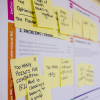Senior product leaders are constantly under pressure to deliver new upgrades while managing tight timelines with limited resources.
They’re also likely grappling with scope creep, competing stakeholder demands, a crowded market, data silos, and teams slow to adopt agile methods.
There’s a way out of this, and it requires a shift in perspective. Rather than continually adding to your product, focus on doing less but doing them well.
By building less and learning more, you’ll be delivering a well-designed product with fewer features instead of a product with plenty of half-baked features.
Peter Drucker once said, “There’s nothing so useless as doing efficiently that which should not be done at all.” While he stated it as a management principle, it should also apply to your product strategy.
Designing a great product requires careful thought backed by hard data, and the discipline to reject ideas that aren’t bringing value to your users.
Why Should You Build Less and Learn More?
1. You’re more likely to deliver real value to users
It’s better to focus on a few things and excel at them than to try to do everything and fail. By concentrating on experimenting quickly and building less, you’ll deliver a smaller scope faster, but one that’s more likely to impress users.
Users care less about the number of features a product has. They care more about whether a product can solve their problems, make their lives easier, save them money and time, or achieve any other objectives.
The best product strategies treat knowledge as the fuel for the next step forward.
2. You’ll reduce product risks by discovering flaws early
The biggest danger isn’t failing; it’s spending a lot of time and money only to fail. By learning more and delivering less, you’re taking a more calculated risk in every product idea.
You can start by analysing market data and user feedback, as well as assessing the technical feasibility and project profitability. Then design the smallest feature or upgrade to test your idea. Fast, low-cost tests enable you to identify flaws in your ideas early, before a rollout that consumes a significant amount of time and budget.
3. You’ll be able to use your resources more effectively
UX designer and developer time is valuable, and you want to maximise the resources that you have. Doing many things at once will exhaust teams, and they’re likely to suffer from burnout.
Managing smaller projects or sprints is easier and more effective. Teams can work on prototypes and MVPs to test the idea first and ensure it’s better than the product’s competitors.
4. You’ll deliver products faster
Speed matters in business, especially in a fierce market. When you have a large scope, you’ll have more maintenance, more dependencies, and more customer expectations to meet. This also limits organisational flexibility and agility. Changing or pivoting becomes cumbersome.
Focusing on smaller builds lets teams move much faster. Each product cycle will sharpen your strategy, align teams, and maximise every dollar spent.
How to Build Less, Experiment More
Smaller incremental builds focus on testing ideas rapidly, delivering bite-sized improvements, and continually iterating based on user feedback. To adopt this approach, consider updating strategies, streamlining processes, adjusting governance, and nurturing a culture that supports learning.
Product strategy
Your product strategy should adopt a learning-first approach. You can start by removing big plans and replacing them with flexible, outcome-driven goals that focus on solving user problems.
Allocate a budget and time for experiments as well. Start investing more in prototypes, pilot projects, sprints, and user testing. You should prioritise projects or tasks that can help you learn more about your users and market to de-risk your product before making a huge commitment.
Product Process
Next, review existing processes and workflows. Teams need to have access to real-time analytics, user research, and customer feedback for easy learning. Implement a faster feedback loop, removing roadblocks and unnecessary tasks.
One way to remove roadblocks is by speeding up decision-making. Encourage cross-functional collaboration among teams to promote team alignment and minimise miscommunication. Try time-limited sprints to guide teams in their experiments.
Governance
People can build great products, provided they have the autonomy to make their own decisions and plan their own work. By decentralising authority, things can move faster, experiments can be conducted quickly, and the learning can be shared more easily.
You can set clear high-level goals and success metrics, so teams have direction without heavy oversight. Support them with coaching and resources instead of adding layers of red tape. Sometimes, the best way to manage is to simply trust others.
Cultural shift
A shift in organisational culture requires starting from the top, and leaders need to prioritise experimentation first.
It’s crucial to be transparent by sharing data, assumptions, and results openly. Encourage cross-functional squads where design, engineering, and business stakeholders collaborate to identify the riskiest assumptions and test them first.
Ultimately, it’s about creating an environment where validating ideas takes precedence over delivering a lengthy list of features.
The Bottom Line
Building less and learning more boils down to discipline and focus. When strategies prioritise discovery, processes enable rapid feedback, governance supports autonomy, and culture rewards experimentation, you can build features that truly matter to users.
It’s a smarter approach. By embracing smaller, validated ideas instead of endless feature lists, your organisation can move faster, reduce risk, and maximise every dollar spent.







